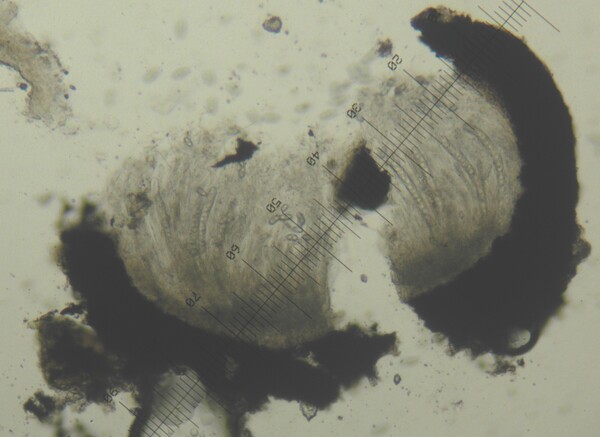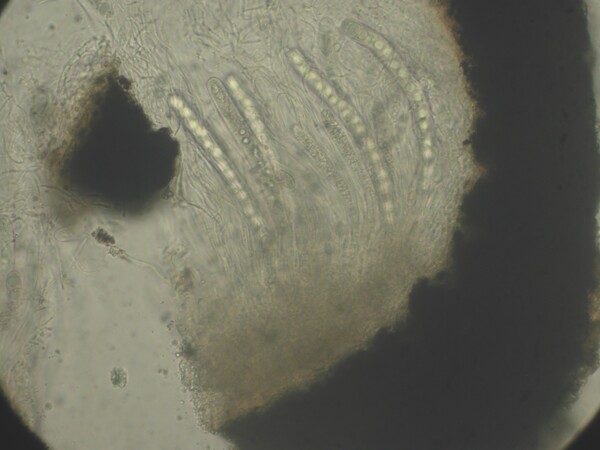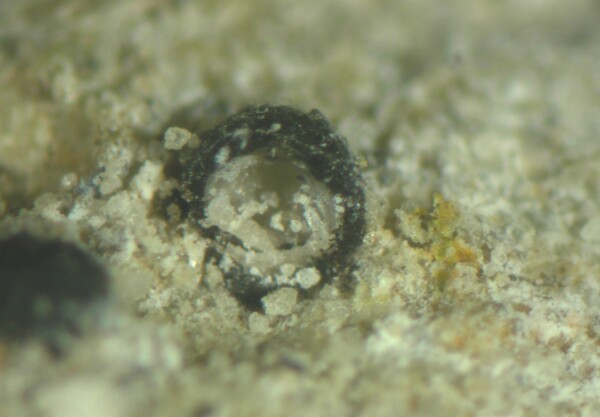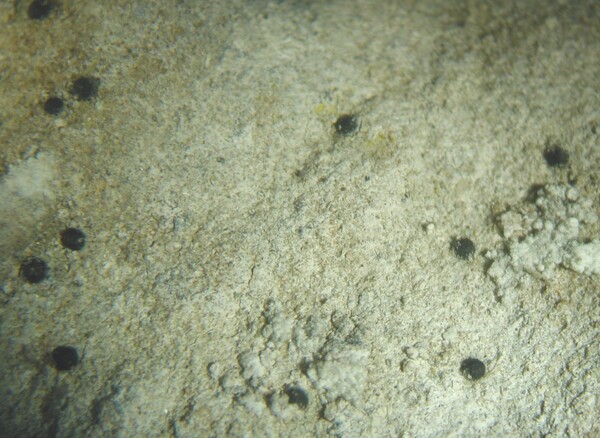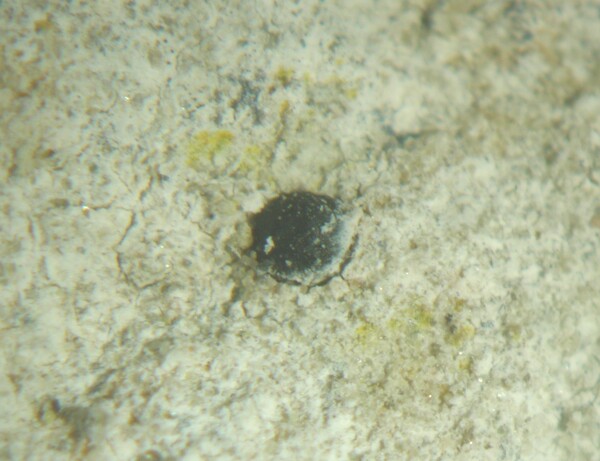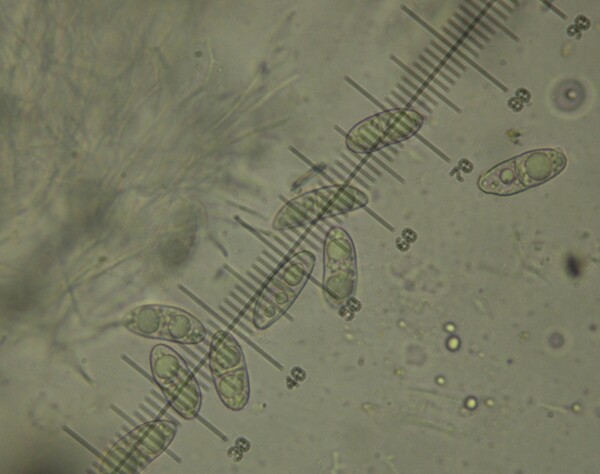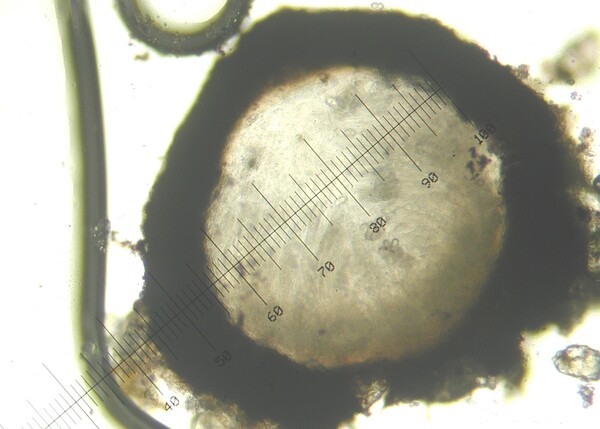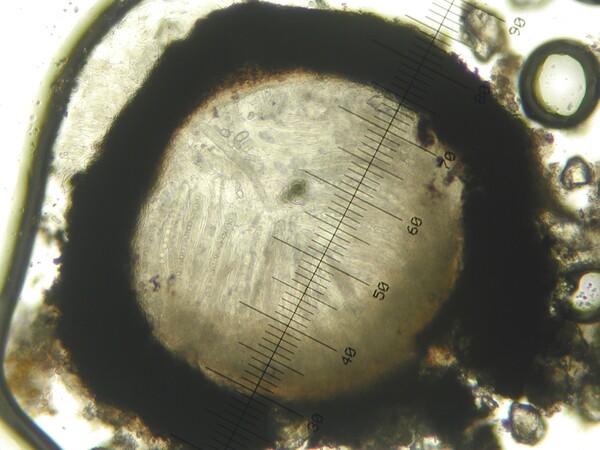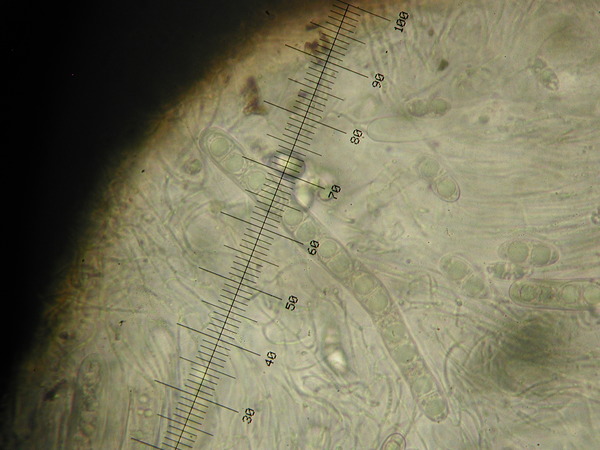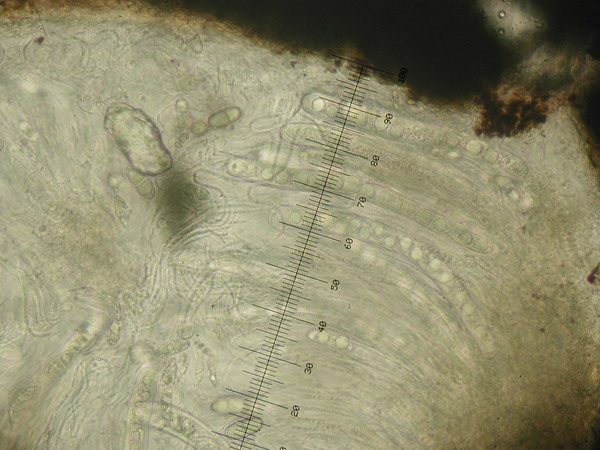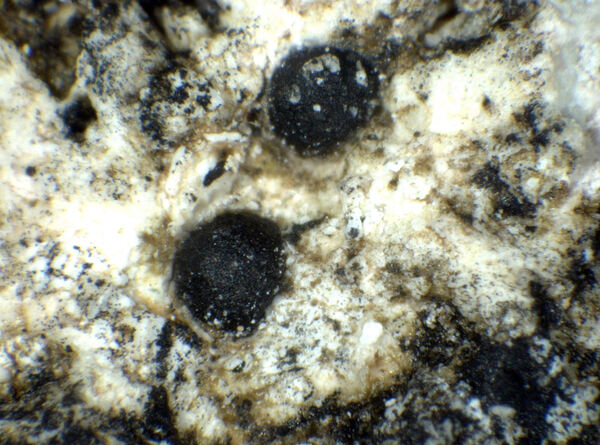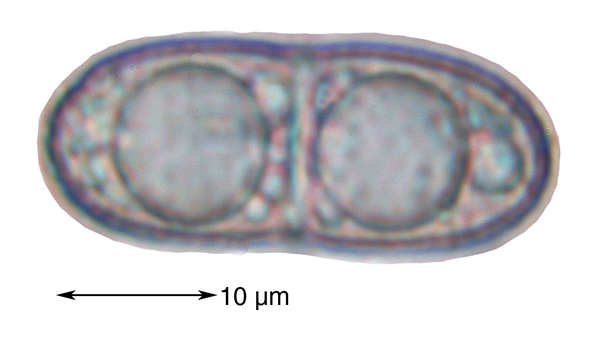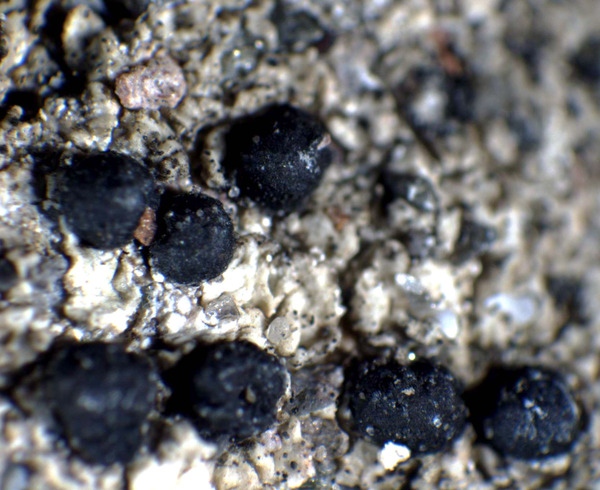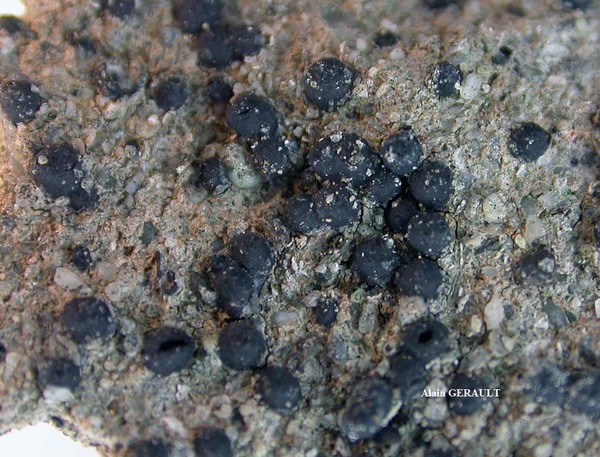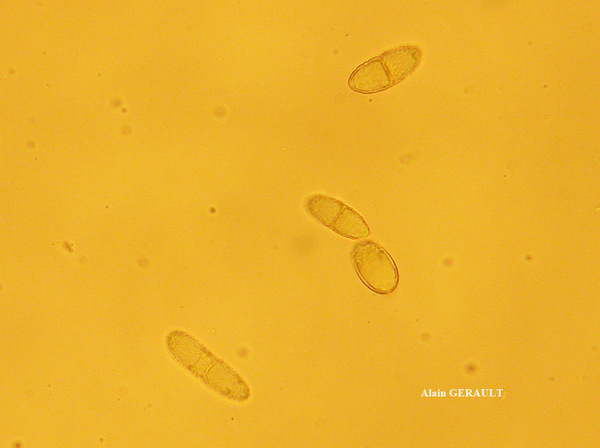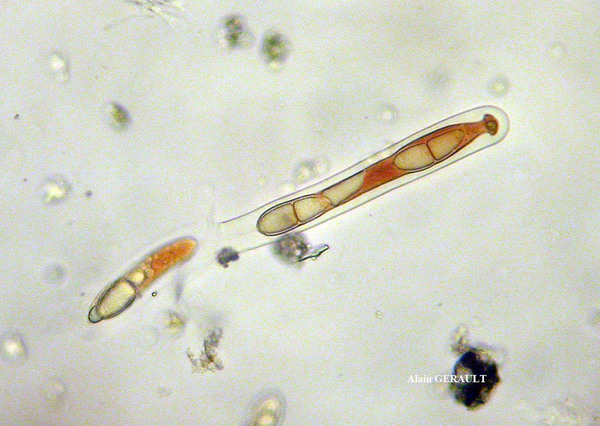Acrocordia salweyi (Nyl.) A.L. Sm.
Monogr. Brit. Lich., 2: 315, 1911. Basionym: Verrucaria salweyi Nyl. - Act. Soc. linn. Bordeaux, 21: 435, 1856.
Synonyms: Arthopyrenia salweyi (Nyl.) Zahlbr.; Leiophloea salweyi (Nyl.) Trevis.
Distribution: N - TAA (Nascimbene 2008b), Lig (Giordani & al. 2016). C - Tosc. S - Camp (Aprile & al. 2003b), Cal (Puntillo 1996), Si (Ottonello & Salone 1994).
Description: Thallus crustose, endosubstratic or thinly episubstratic, whitish to pale brownish grey, thin, smooth, rimose or granular. Perithecia black, 0.7-1.5 mm across, one quarter- to half-immersed, the ostiole not papillose. Involucrellum black, tightly incurved around the exciple and often completely surrounding it; exciple globose, colourless or pale brownish; hamathecium of persistent, slender, sparingly branched, long-celled pseudoparaphyses; periphyses absent; hymenial gel I-, K/I-. Asci 8-spored, narrowly cylindrical, K/I-, fissitunicate, the apical dome with a broad ocular chamber surmounted by a hemispherical structure, with uniseriately arranged spores. Ascospores 1(-3)-septate, hyaline, ellipsoid with rounded ends, (17-)20-35 x (9-)10-15 μm, surrounded by a perispore which appears verrucose in water, smooth in K. Pycnidia rather rare, black, 0.2-0.3 mm across. Conidia 1-celled, hyaline, ellipsoid. Photobiont trentepohlioid. Spot tests: K-, C-, KC-, P-, UV-. Chemistry: without lichen substances.Note: an apparently Mediterranean-Atlantic, mild-temperate species ranging from Macaronesia to Norway, but also known from central Europe, found on soft calcareous substrata (mortar, calciferous sandstone) in warm-humid areas below the montane belt. Mostly Tyrrhenian in Italy, but also reported from the Alps.
Growth form: Crustose
Substrata: rocks
Photobiont: Trentepohlia
Reproductive strategy: mainly sexual
Most common in areas with a humid-warm climate (e.g. most of Tyrrenian Italy)
Commonnes-rarity: (info)
Alpine belt: absent
Subalpine belt: absent
Oromediterranean belt: absent
Montane belt: absent
Submediterranean belt: extremely rare
Padanian area: absent
Humid submediterranean belt: very rare
Humid mediterranean belt: very rare
Dry mediterranean belt: absent

Predictive model
Herbarium samples
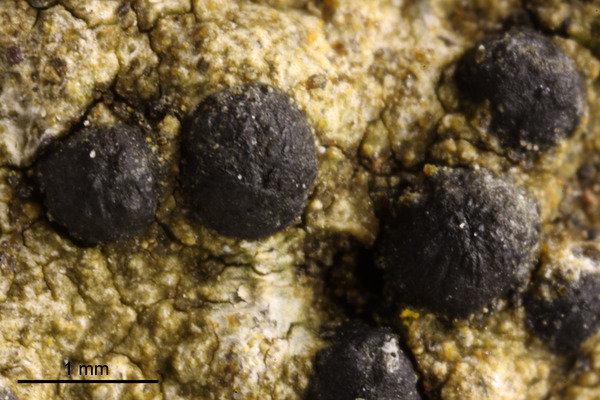

Felix Schumm – CC BY-SA 4.0
[14215], Portugal, Azoren, Terceira, Angra Do Heroismo, Fortaleza de Dao Joao Baptista, 38°39,171' N, 27°13,457' W, ca. 44 m. Leg. Aptroot & Schumm 17.07.2008
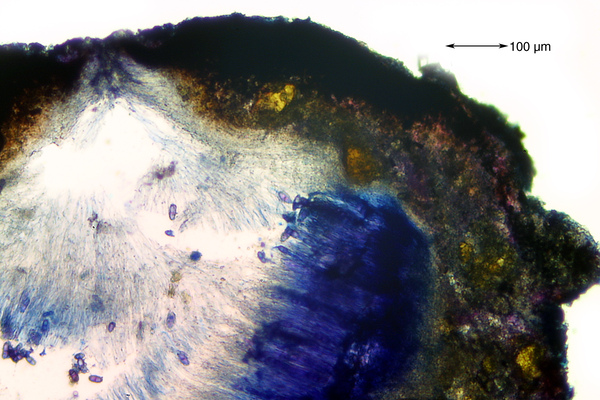

Felix Schumm – CC BY-SA 4.0
[14215], Portugal, Azoren, Terceira, Angra Do Heroismo, Fortaleza de Dao Joao Baptista, 38°39,171' N, 27°13,457' W, ca. 44 m. Leg. Aptroot & Schumm 17.07.2008
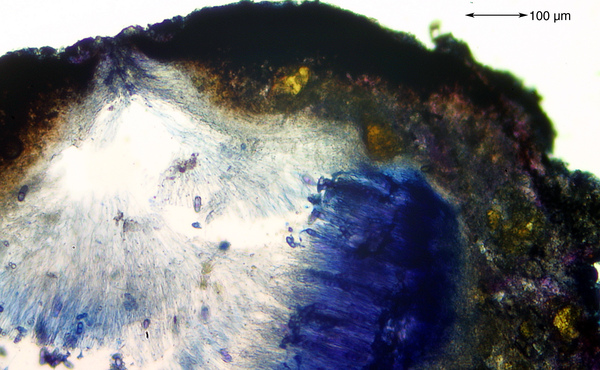

Felix Schumm – CC BY-SA 4.0
[14215], Portugal, Azoren, Terceira, Angra Do Heroismo, Fortaleza de Dao Joao Baptista, 38°39,171' N, 27°13,457' W, ca. 44 m. Leg. Aptroot & Schumm 17.07.2008
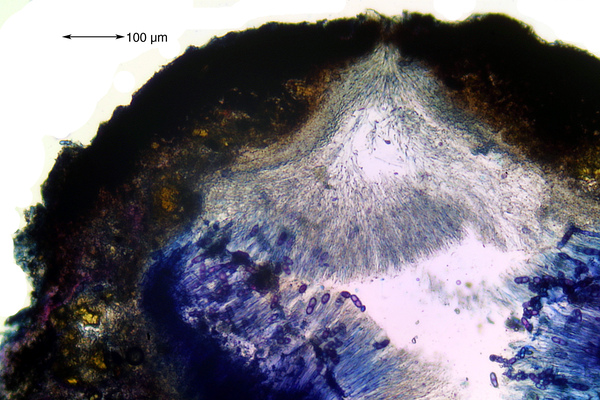

Felix Schumm – CC BY-SA 4.0
[14215], Portugal, Azoren, Terceira, Angra Do Heroismo, Fortaleza de Dao Joao Baptista, 38°39,171' N, 27°13,457' W, ca. 44 m. Leg. Aptroot & Schumm 17.07.2008
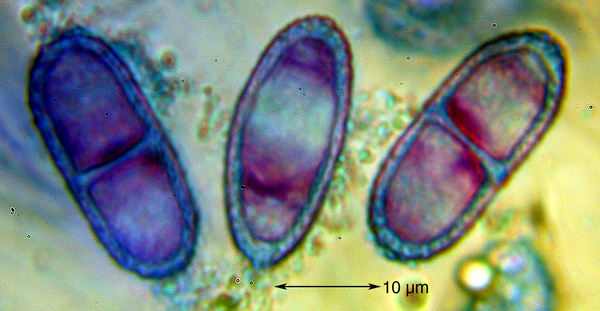

Felix Schumm – CC BY-SA 4.0
[14215], Portugal, Azoren, Terceira, Angra Do Heroismo, Fortaleza de Dao Joao Baptista, 38°39,171' N, 27°13,457' W, ca. 44 m. Leg. Aptroot & Schumm 17.07.2008


Felix Schumm – CC BY-SA 4.0
[14215], Portugal, Azoren, Terceira, Angra Do Heroismo, Fortaleza de Dao Joao Baptista, 38°39,171' N, 27°13,457' W, ca. 44 m. Leg. Aptroot & Schumm 17.07.2008
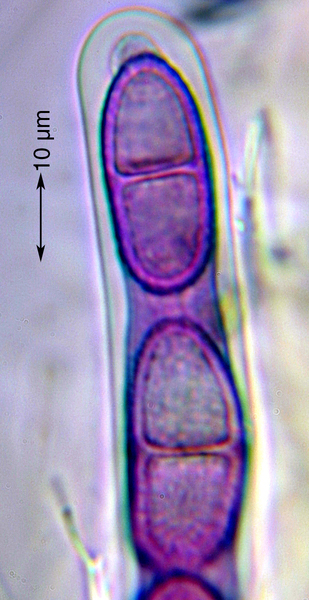

Felix Schumm – CC BY-SA 4.0
[14215], Portugal, Azoren, Terceira, Angra Do Heroismo, Fortaleza de Dao Joao Baptista, 38°39,171' N, 27°13,457' W, ca. 44 m. Leg. Aptroot & Schumm 17.07.2008
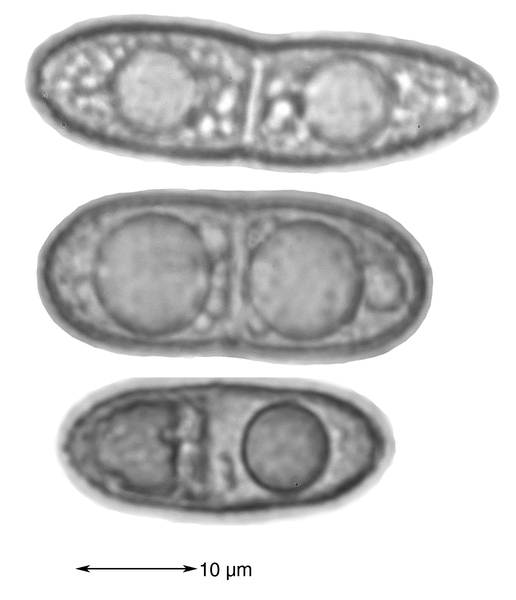

Felix Schumm – CC BY-SA 4.0
[14215], Portugal, Azoren, Terceira, Angra Do Heroismo, Fortaleza de Dao Joao Baptista, 38°39,171' N, 27°13,457' W, ca. 44 m. Leg. Aptroot & Schumm 17.07.2008
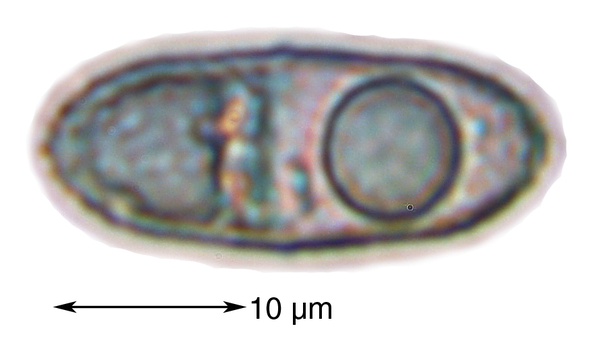

Felix Schumm – CC BY-SA 4.0
[14215], Portugal, Azoren, Terceira, Angra Do Heroismo, Fortaleza de Dao Joao Baptista, 38°39,171' N, 27°13,457' W, ca. 44 m. Leg. Aptroot & Schumm 17.07.2008


Felix Schumm – CC BY-SA 4.0
[14215], Portugal, Azoren, Terceira, Angra Do Heroismo, Fortaleza de Dao Joao Baptista, 38°39,171' N, 27°13,457' W, ca. 44 m. Leg. Aptroot & Schumm 17.07.2008
Growth form: Crustose
Substrata: rocks
Photobiont: Trentepohlia
Reproductive strategy: mainly sexual
Most common in areas with a humid-warm climate (e.g. most of Tyrrenian Italy)
Commonnes-rarity: (info)
Alpine belt: absent
Subalpine belt: absent
Oromediterranean belt: absent
Montane belt: absent
Submediterranean belt: extremely rare
Padanian area: absent
Humid submediterranean belt: very rare
Humid mediterranean belt: very rare
Dry mediterranean belt: absent

Predictive model
| Herbarium samples |


Felix Schumm – CC BY-SA 4.0
[14215], Portugal, Azoren, Terceira, Angra Do Heroismo, Fortaleza de Dao Joao Baptista, 38°39,171' N, 27°13,457' W, ca. 44 m. Leg. Aptroot & Schumm 17.07.2008


Felix Schumm – CC BY-SA 4.0
[14215], Portugal, Azoren, Terceira, Angra Do Heroismo, Fortaleza de Dao Joao Baptista, 38°39,171' N, 27°13,457' W, ca. 44 m. Leg. Aptroot & Schumm 17.07.2008


Felix Schumm – CC BY-SA 4.0
[14215], Portugal, Azoren, Terceira, Angra Do Heroismo, Fortaleza de Dao Joao Baptista, 38°39,171' N, 27°13,457' W, ca. 44 m. Leg. Aptroot & Schumm 17.07.2008


Felix Schumm – CC BY-SA 4.0
[14215], Portugal, Azoren, Terceira, Angra Do Heroismo, Fortaleza de Dao Joao Baptista, 38°39,171' N, 27°13,457' W, ca. 44 m. Leg. Aptroot & Schumm 17.07.2008


Felix Schumm – CC BY-SA 4.0
[14215], Portugal, Azoren, Terceira, Angra Do Heroismo, Fortaleza de Dao Joao Baptista, 38°39,171' N, 27°13,457' W, ca. 44 m. Leg. Aptroot & Schumm 17.07.2008


Felix Schumm – CC BY-SA 4.0
[14215], Portugal, Azoren, Terceira, Angra Do Heroismo, Fortaleza de Dao Joao Baptista, 38°39,171' N, 27°13,457' W, ca. 44 m. Leg. Aptroot & Schumm 17.07.2008


Felix Schumm – CC BY-SA 4.0
[14215], Portugal, Azoren, Terceira, Angra Do Heroismo, Fortaleza de Dao Joao Baptista, 38°39,171' N, 27°13,457' W, ca. 44 m. Leg. Aptroot & Schumm 17.07.2008


Felix Schumm – CC BY-SA 4.0
[14215], Portugal, Azoren, Terceira, Angra Do Heroismo, Fortaleza de Dao Joao Baptista, 38°39,171' N, 27°13,457' W, ca. 44 m. Leg. Aptroot & Schumm 17.07.2008


Felix Schumm – CC BY-SA 4.0
[14215], Portugal, Azoren, Terceira, Angra Do Heroismo, Fortaleza de Dao Joao Baptista, 38°39,171' N, 27°13,457' W, ca. 44 m. Leg. Aptroot & Schumm 17.07.2008


 INDEX FUNGORUM
INDEX FUNGORUM
 GBIF
GBIF
 DOLICHENS
DOLICHENS
